The Complete Guide to Player Churn Prevention in Online Casinos: Proven Strategies to Boost Player Retention in 2025
.avif)
Player churn prevention has emerged as the single most critical factor determining long-term success for online casino operators. With retention rates dropping to less than 30% on day 1 and plummeting to less than 8% on day 7, the casino industry faces an unprecedented retention crisis. This in-depth guide explores 15 proven strategies that combine AI-powered analytics, gamification mechanics, and personalized engagement to transform player retention and maximize lifetime value.
The economics are stark: acquiring new players costs 5-7 times more than retaining existing ones, while a mere 5% increase in retention rates can boost profits by up to 95%. Against this backdrop, operators who master churn prevention strategies can achieve sustainable competitive advantages in an increasingly crowded marketplace.
The Churn Crisis in Online Casinos
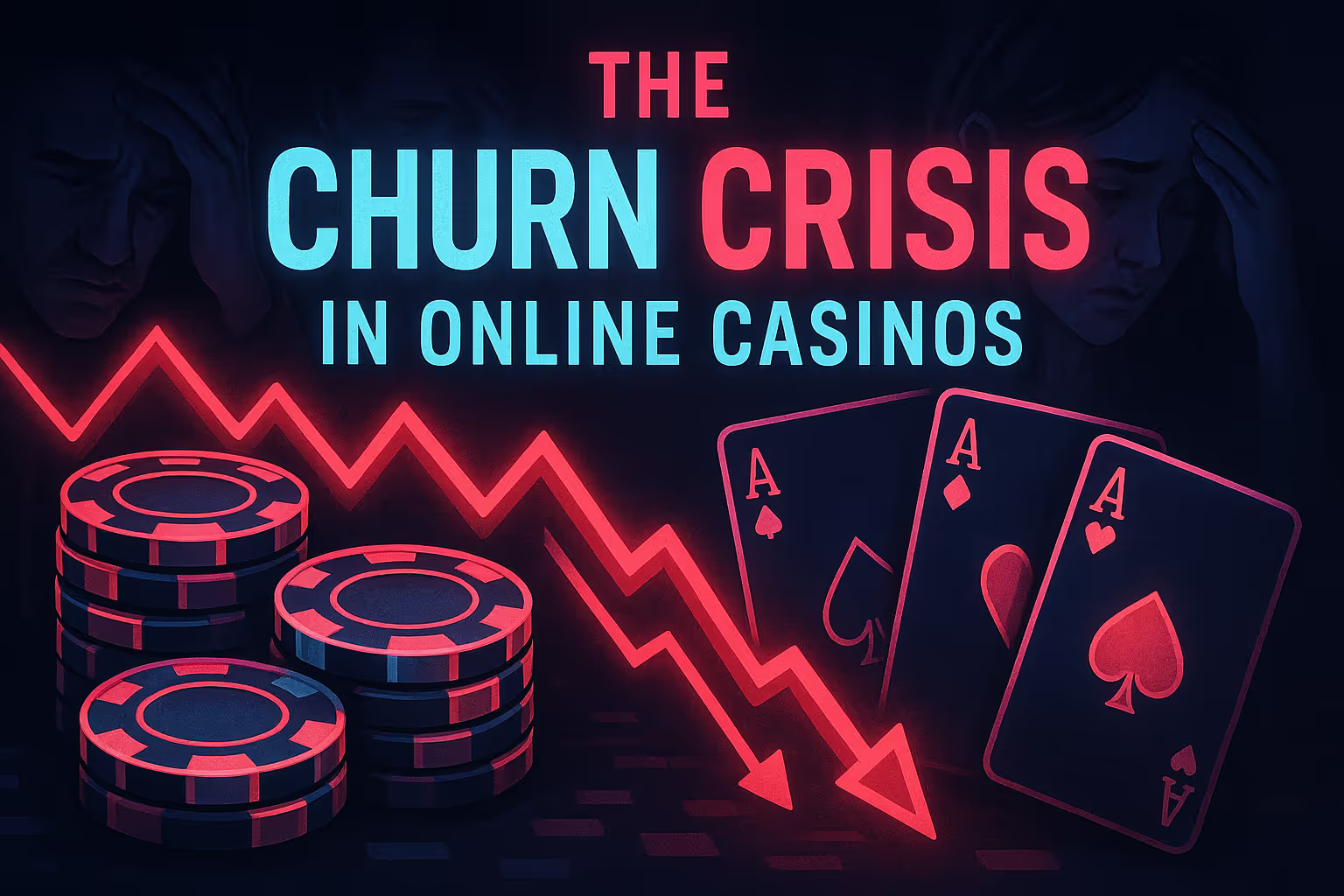
The Retention Reality
The online casino industry confronts alarming retention statistics that underscore the urgent need for sophisticated churn prevention strategies. Recent research reveals that only 6.19% of active players in the last quarter of 2024 were new players, indicating that the vast majority of casino revenue comes from retained players rather than new acquisitions.
The retention curve tells a sobering story:
- Day 1 retention: Less than 30%
- Day 7 retention: Less than 8%
- Day 30 retention: 2-20% across different operators
These figures represent a fundamental challenge to the traditional acquisition-focused growth model that many operators have relied upon.
The Economics of Churn
The financial impact of player churn extends far beyond simple revenue loss. Customer acquisition costs (CAC) in the iGaming industry range from $250-$500 per user, with sports betting reaching as high as $800+ during major events. When factoring in the 5-7x cost differential between acquisition and retention, the economic case for churn prevention becomes overwhelming.
Industry analysis reveals that just 2% of players can account for more than half of total earnings, making the retention of high-value players absolutely critical for operational sustainability. Losing even a small number of these premium players can create devastating financial consequences that ripple through the entire business.
Defining Churn in Casino Context
Most operators define a player as churned when they have 30+ days without real bets or deposits. However, this definition varies across operators, with some using shorter timeframes of 14-21 days depending on their typical player engagement patterns. Advanced operators now employ AI-powered churn prediction models that can identify at-risk players as early as the first day of inactivity, enabling proactive intervention before complete disengagement occurs.
Understanding the Psychology Behind Player Churn

Psychological Triggers Driving Churn
Understanding why players leave requires deep insight into the psychological mechanisms that drive gambling behavior. Loss aversion emerges as a primary churn driver, where the psychological pain of losing exceeds the pleasure of winning by a factor of 2:1. When players experience consecutive losses without adequate positive reinforcement, they often abandon the platform entirely.
Variable reward schedules represent the psychological foundation of casino engagement. Games that provide unpredictable rewards tickle the brain's dopamine systems, creating the neurochemical basis for continued play. However, when reward frequency drops below player expectations, the psychological investment diminishes rapidly, leading to churn.
Emotional Engagement Factors
Three core emotional drivers influence player retention:
Excitement and Anticipation: Players seek the thrill of uncertain outcomes. When games become predictable or fail to deliver sufficient excitement, engagement wanes.
Social Proof and Status: Leaderboards, rankings, and badges provide public validation, enhancing emotional investment in the platform. Players who achieve visible status markers demonstrate significantly higher retention rates.
Fear of Missing Out (FOMO): Limited-time offers, countdown timers, and event-based games create urgency that drives continued engagement. This psychological trigger proves particularly effective when combined with personalized offers based on player behavior.
Behavioral Patterns Predicting Churn
Advanced analytics can identify specific behavioral patterns that reliably predict churn risk:
- Session frequency changes: Decreasing play frequency often precedes complete disengagement
- Bet size variations: Dramatic increases or decreases in wager amounts signal changing player psychology
- Game exploration patterns: Players who stop trying new games often lose interest in the platform
- Communication responsiveness: Declining response rates to promotional offers indicate disengagement
AI-Powered Churn Prediction Models
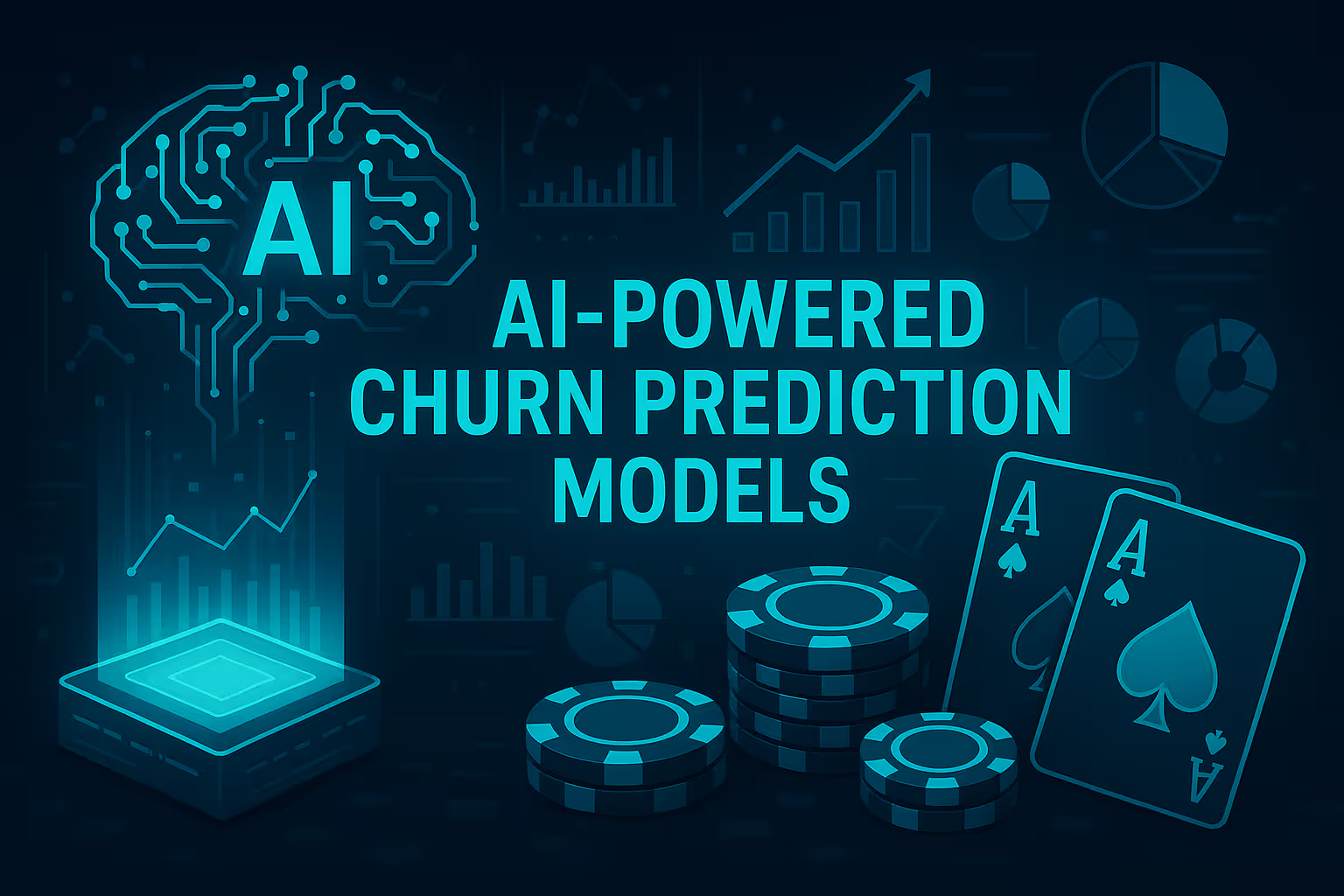
Machine Learning for Player Behavior Analysis
The integration of artificial intelligence has revolutionized churn prediction capabilities. Fast Track's AI Player Churn Model uses seven sub-models to analyze player behavior and make accurate predictions in sync with each operator's player base. These systems continuously train on live data, ensuring predictions remain relevant as player behaviors evolve.
Modern churn prediction models employ multiple machine learning techniques:
E-CHAID (Enhanced Chi-Squared Automatic Interaction Detection): This algorithm excels at identifying complex interaction patterns between variables that traditional regression analysis might miss.
Random Forest Classifiers: These ensemble methods can achieve testing accuracies of 85-89% in predicting player behavior, making them highly reliable for operational decision-making.
Deep Learning Neural Networks: Advanced models can recognize intricate patterns in player behavior that simpler algorithms cannot detect, particularly for long-term behavior forecasting.
{{cta-banner}}
Real-Time Behavioral Analysis
Real-time data processing capabilities help operators respond to churn signals within minutes rather than days. These systems analyze multiple data streams simultaneously:
- Session duration and frequency patterns
- Game engagement metrics
- Deposit and withdrawal behaviors
- Communication interaction rates
- Cross-platform activity patterns
ROI of Predictive Models
Implementation of AI-powered churn prediction delivers measurable returns:
- Massive reduction in churn rates across multiple operator case studies
- Major increase in Net Gaming Revenue (NGR) through timely interventions
- Great reduction in wasteful bonus distribution by targeting at-risk players more precisely
The investment in predictive analytics typically pays for itself within 3-6 months through improved retention rates and reduced acquisition costs.
The Power of Gamification in Player Retention

Core Gamification Elements
Gamification transforms traditional casino experiences by incorporating game-like elements that enhance engagement and retention. Points, levels, badges, and leaderboards form the foundation of effective gamification systems.
Mission and Quest Systems: These provide players with clear objectives beyond simple iGaming, creating additional reasons to return to the platform. Missions can range from "Complete 10 spins on slot games" to more complex multi-stage challenges that span several days.
Tournament and Competition Mechanics: Competitive elements drive engagement by allowing players to compete for top rankings. Time-limited tournaments create urgency while providing opportunities for recognition and rewards.
VIP Tier Progression: Tiered systems encourage consistent play by offering increasingly valuable benefits at each level. The sense of progression taps into players' intrinsic motivation to achieve and improve.
Psychological Principles Behind Gamification
Progression Loops: These create psychological satisfaction through advancement and achievement. Players experience a sense of accomplishment when completing missions or reaching new levels, independent of gambling outcomes.
Social Recognition: Badge systems and leaderboards provide public validation of player achievements, creating community engagement and reducing churn through social connections.
Loss Aversion Mitigation: Gamification elements can help offset the psychological impact of gambling losses by providing alternative sources of positive reinforcement through points, achievements, and progression.
Measurable Impact on Retention
Empirical evidence demonstrates gamification's effectiveness:
- Platforms using gamification achieve 75% retention versus 50% for non-gamified platforms
- 30% average revenue increase with properly implemented gamification systems
- Major increase in lifetime value (LTV) through gamification engagement
The key lies in implementation sophistication. Basic point systems provide minimal impact, while integrated gamification that responds to player behavior and preferences delivers substantial returns.
Real-Time Engagement and Personalization
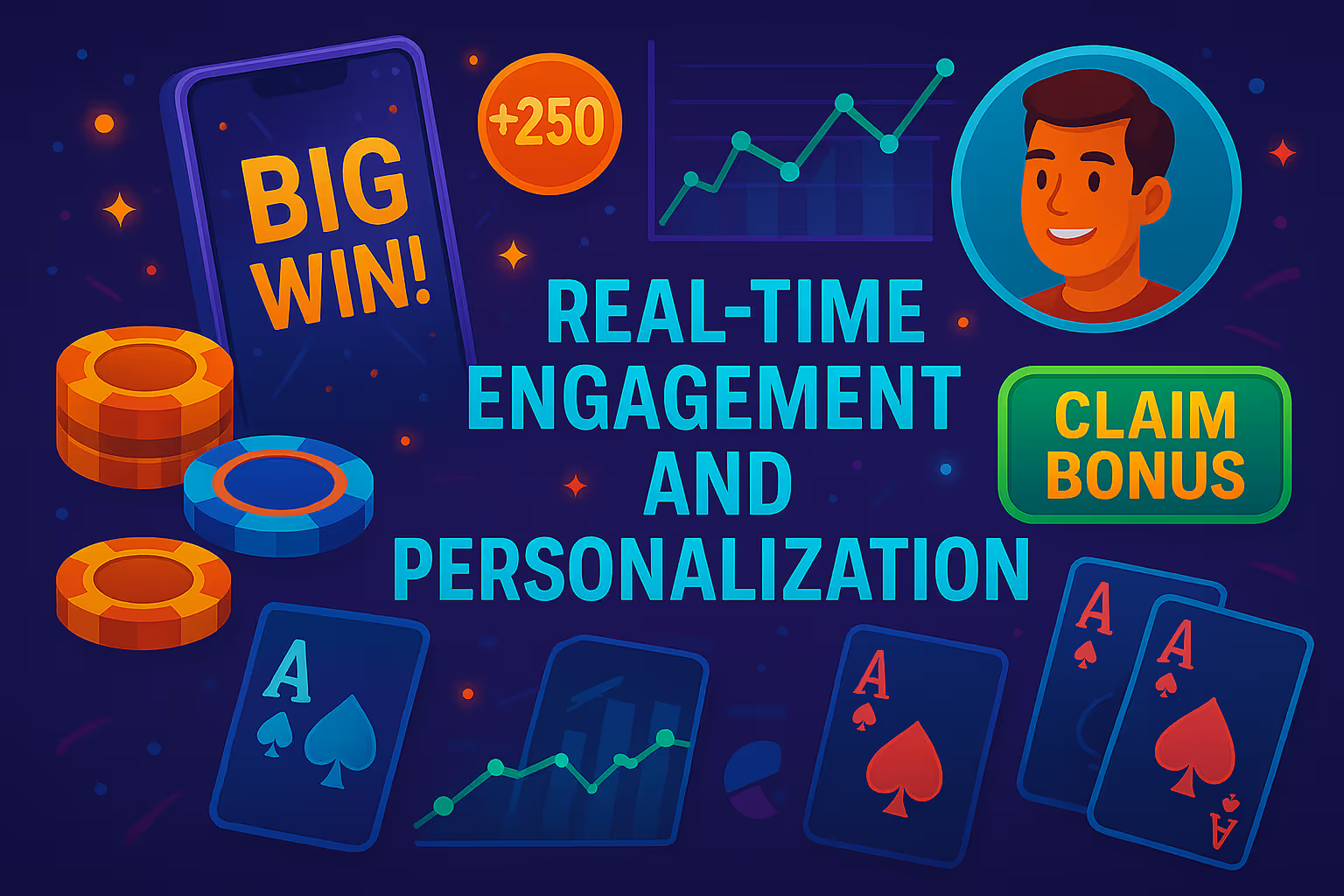
Importance of Real-Time Data Processing
Real-time engagement capabilities represent a critical competitive advantage in churn prevention. Modern players expect immediate responses to their actions, and delays in recognition or rewards can drive disengagement. Systems that can process and respond to player behavior within milliseconds create smooth experiences that boost retention.
Dynamic Content Personalization
Advanced platforms utilize behavioral data to create hyper-personalized experiences that adapt to individual player preferences. This includes:
Game Recommendations: AI algorithms analyze playing patterns to suggest games that align with individual preferences, increasing session duration and frequency..
Bonus Timing Optimization: Predictive models determine the optimal moments to offer bonuses based on player activity patterns, maximizing acceptance rates and effectiveness.
Content Customization: Real-time personalization engines adapt game suggestions, promotional offers, and communication timing to match individual player psychology.
Multi-Channel Engagement Strategies
Effective retention requires coordinated engagement across multiple touchpoints:
- Email automation with personalized timing and content
- SMS alerts for time-sensitive offers and reminders
- In-platform notifications triggered by behavioral patterns
- Push notifications for mobile app users
- Social media retargeting for comprehensive coverage
A/B testing frameworks enable continuous optimization of messaging, timing, and offer structures across all channels.
Real-Time Intervention Strategies
When predictive models identify churn risk, operators can deploy immediate interventions:
Personalized Bonus Offers: Tailored to the player's preferred games and typical bet amounts.
VIP Account Manager Contact: High-value players receive direct outreach from dedicated representatives.
Gamification Triggers: Special missions or tournament invitations designed to re-engage the specific player.
Advanced Player Segmentation Strategies
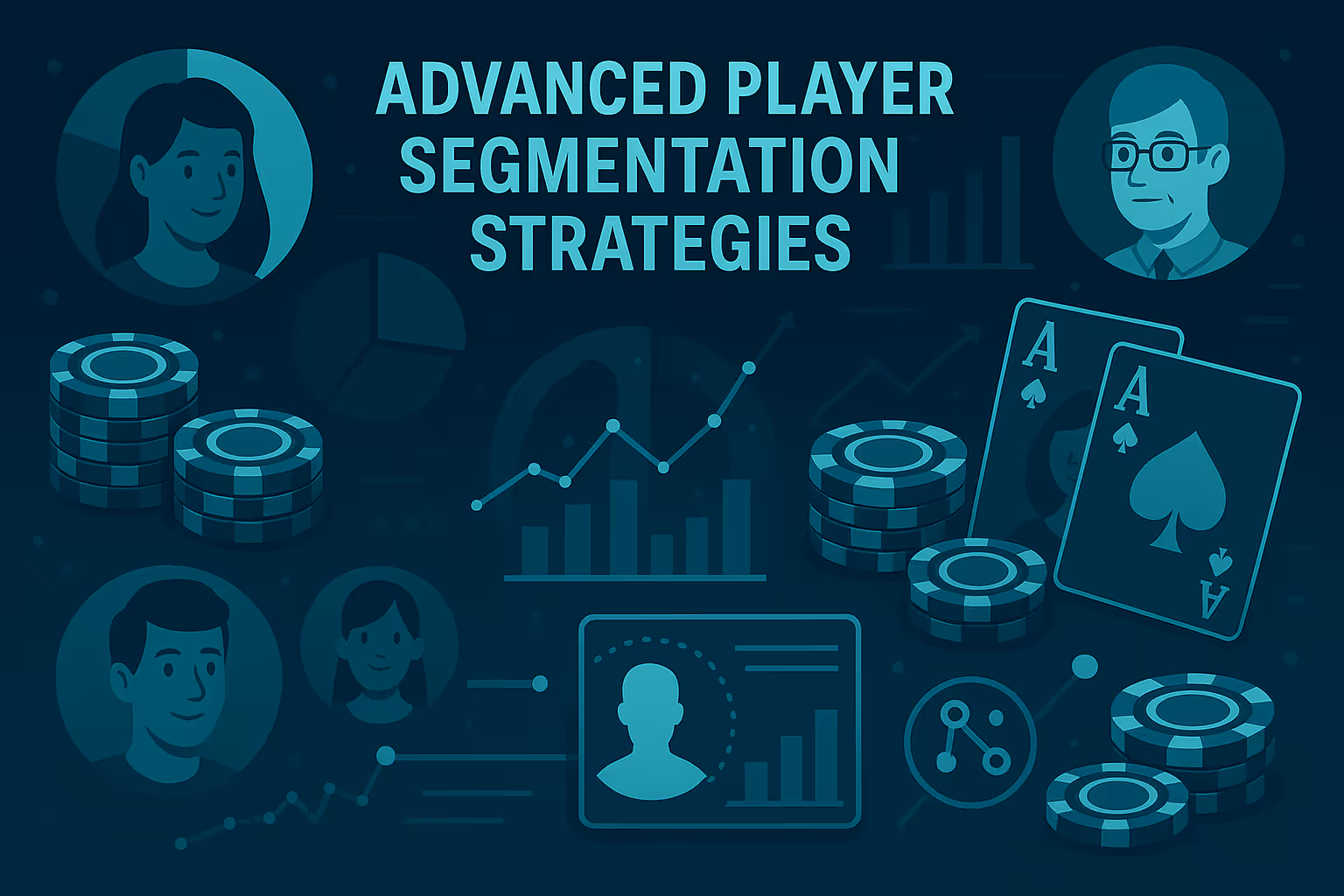
RFM Analysis Implementation
Recency, Frequency, and Monetary (RFM) analysis represents the gold standard for player segmentation. This methodology evaluates players across three critical dimensions:
- Recency: How recently a player made their last deposit or placed their last bet
- Frequency: How often the player engages with the platform over defined time periods
- Monetary: The total value of the player's deposits and wagering activity
RFM segmentation gives operators the power to create targeted campaigns for specific player groups, with each segment receiving communications and offers tailored to their engagement patterns and value potential.
Behavioral vs. Demographic Segmentation
While traditional demographic segmentation provides basic insights, behavioral segmentation delivers significantly higher predictive power for churn prevention. Behavioral segments focus on:
- Game preference patterns
- Session timing and duration
- Risk tolerance levels
- Response rates to promotions
- Cross-platform usage patterns
VIP and High-Roller Identification
Early VIP detection systems use machine learning to identify potential high-value players within their first 24 hours of activity. These models analyze multiple behavioral signals:
- Initial deposit amounts and patterns
- Game selection and bet sizing
- Session duration and frequency
- Response to welcome offers
AI-powered VIP identification can predict future high-value players with great accuracy, helping operators provide premium treatment from the earliest stages of the player journey.
Micro-Segmentation Using AI
Advanced operators employ AI-driven micro-segmentation that creates hundreds or thousands of distinct player groups. This granular approach enables:
- Highly specific bonus offers tailored to narrow player types
- Game recommendations based on similar player preferences
- Communication timing optimized for each segment's engagement patterns
- Churn prevention strategies customized to specific risk factors
Building Deep Player Journeys

The 6 Stages of Player Journey
Effective churn prevention requires understanding and optimizing each stage of the player lifecycle:
- Awareness: Initial exposure to the casino brand through marketing channels
- Sign-up: Registration process and account creation experience
- First Deposit: Critical conversion moment that determines long-term engagement
- Active Gaming: Period of regular play and platform exploration
- Retention: Ongoing engagement through varied activities and rewards
- Loyalty/VIP: Advanced engagement with premium benefits and personalized service
Critical Touchpoints and Optimization
Each journey stage contains critical touchpoints that significantly influence retention outcomes:
Onboarding Experience: Simplified registration processes with minimal friction while maintaining security requirements. Passport and ID scanning technologies can pre-populate fields and reduce abandonment rates.
Welcome Bonus Structure: Tiered welcome offers that provide multiple engagement opportunities rather than single large bonuses that create acquisition spikes followed by rapid churn.
First Gaming Session: Personalized game recommendations based on initial preferences and successful onboarding flows that guide players to engaging content.
Automated Journey Mapping
Modern CRM systems employ automated journey mapping that tracks player progression and identifies optimization opportunities. These systems can:
- Detect journey stage transitions automatically
- Trigger personalized communications based on progression patterns
- Identify friction points where players commonly disengage
- Deploy intervention strategies when journey progression stalls
Personalization at Each Journey Stage
Hyper-personalization engines adapt the player experience based on behavioral data collected at each journey stage:
- Discovery Stage: Content and game recommendations based on browsing patterns
- Onboarding Stage: Customized welcome sequences based on player preferences
- Active Gaming Stage: Dynamic game suggestions and bonus offers
- Retention Stage: Loyalty program elements tailored to engagement patterns
Loyalty Programs and Retention Mechanics
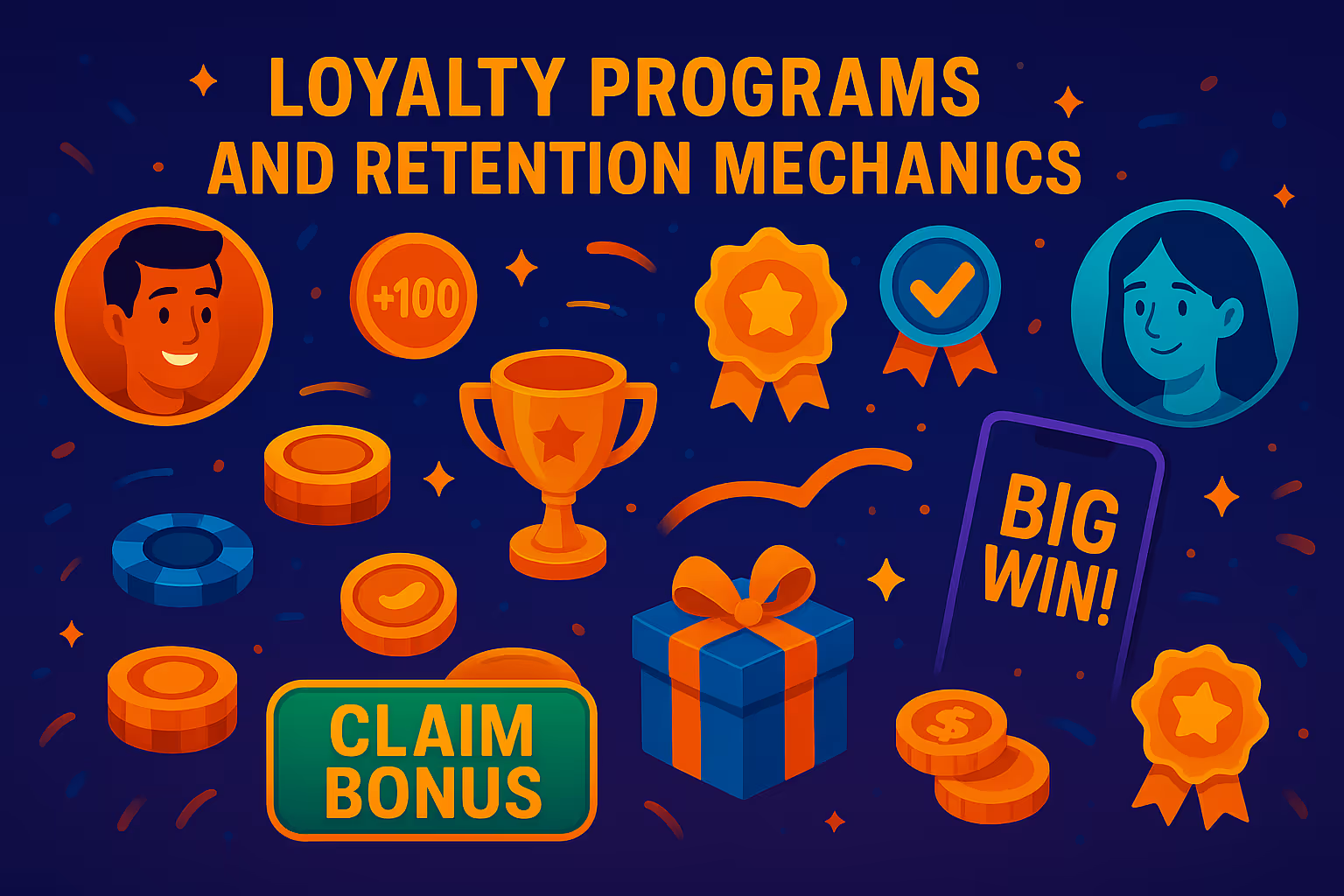
Evolution from Traditional to Gamified Loyalty
Modern casino loyalty programs have evolved far beyond simple point accumulation systems. Contemporary programs integrate gamification elements that create engaging, game-like experiences. These systems combine traditional value rewards with psychological engagement through:
- Tier-based progression with visual feedback
- Achievement badges and milestone celebrations
- Community features that foster social connections
- Personalized challenges and missions
Tier-Based Progression Systems
Effective tier systems create clear advancement paths with increasingly valuable benefits. Best practices include:
Milestone Design: Setting achievable initial tiers with progressively challenging advancement requirements. This maintains motivation while preventing tier inflation.
Benefit Scaling: Each tier provides meaningful incremental value through enhanced bonuses, exclusive games, faster withdrawals, and personalized service.
Visual Progress Indicators: Real-time progress tracking helps players understand their advancement status and proximity to the next tier.
Dynamic Reward Optimization
Advanced loyalty programs employ AI-driven dynamic reward systems that adapt offers based on player behavior and preferences:
- Behavioral Trigger Bonuses: Rewards triggered by specific actions that encourage desired behaviors
- Personalized Cashback Rates: Variable cashback percentages based on player value and risk profiles
- Exclusive Content Access: VIP-only games, tournaments, and events that create exclusivity
- Flexible Redemption Options: Multiple ways to use loyalty points, from bonuses to real-world rewards
{{cta-banner}}
Community Building Through Loyalty
Social elements within loyalty programs significantly enhance retention. Effective community features include:
- Player forums and discussion spaces
- Tournament leaderboards with social recognition
- Referral programs that reward community building
- VIP events and exclusive experiences
Technology Stack for Churn Prevention
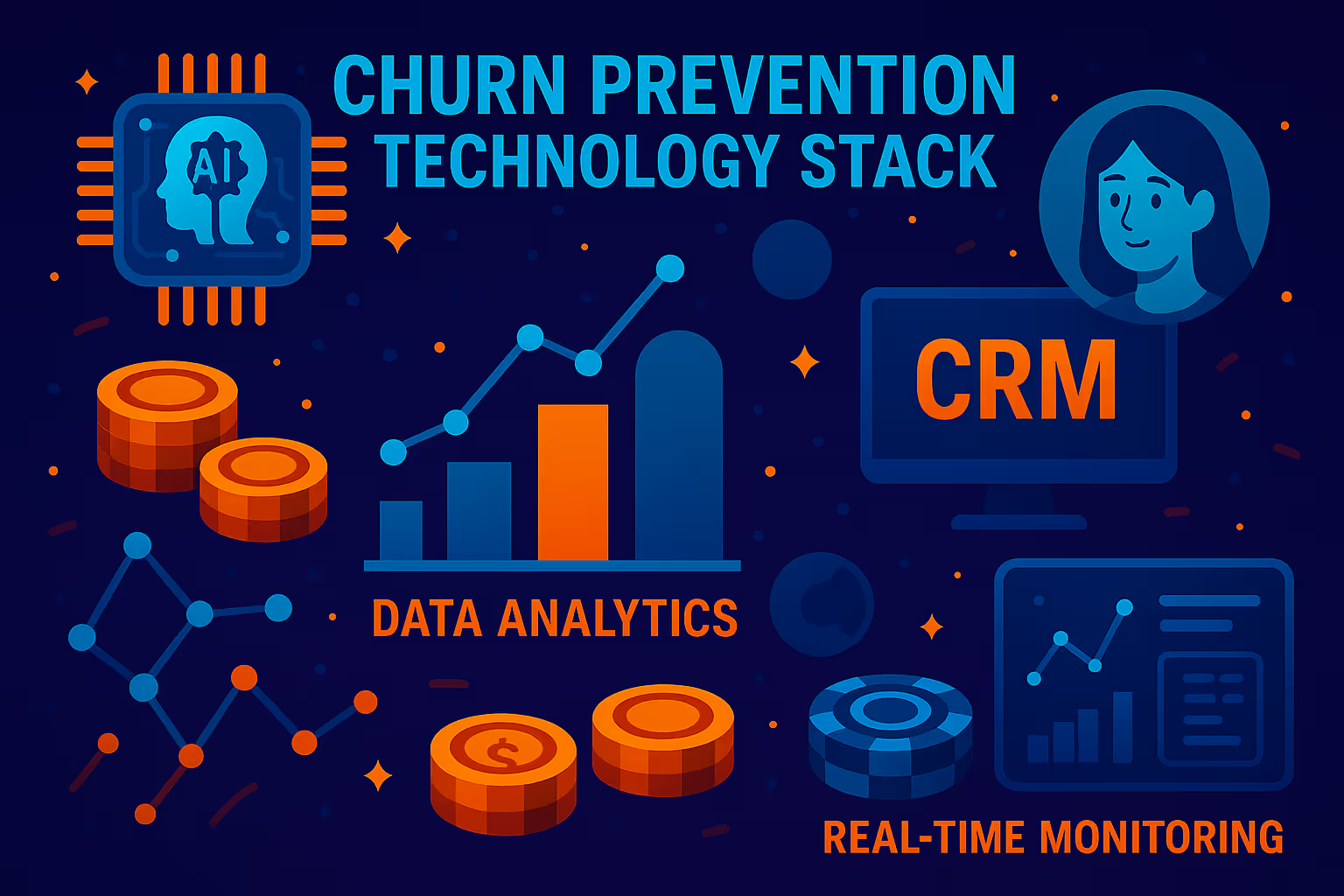
Essential CRM Features for Retention
Modern casino CRM systems must provide comprehensive functionality for effective churn prevention:
Real-Time Data Integration: Consolidation of data from all business systems and providers in real-time enables immediate response to player behavior changes.
Advanced Segmentation Capabilities: Tools for creating sophisticated player segments based on behavioral, demographic, and predictive analytics.
Automated Campaign Management: Workflow automation that triggers personalized communications based on player actions and segment membership.
Predictive Analytics Integration: Built-in machine learning models for churn prediction, LTV forecasting, and optimal timing.
Integration Requirements
Successful retention technology requires seamless integration across multiple systems:
- Game Provider APIs: Direct connections to slot, table game, and live dealer providers for real-time gaming data
- Payment Processing Integration: Transaction data feeds for deposit, withdrawal, and bonus tracking
- Marketing Platform Connectivity: Links to email, SMS, and social media marketing tools Customer Support Systems: Integration with help desk and live chat platforms
Real-Time Data Processing Capabilities
Advanced platforms process millions of player actions per minute to enable immediate response:
- Sub-second response times for personalized offers and recommendations
- Streaming data analytics that identify behavioral changes instantly
- Automated decision engines that trigger interventions without human oversight
- Performance monitoring that ensures system reliability under peak loads
Scalability Considerations
Retention technology must accommodate business growth:
- Horizontal Scaling: Ability to add processing capacity as player bases expand
- Multi-Brand Support: Management of multiple casino brands from a single platform instance
- Geographic Expansion: Support for multiple markets, languages, and regulatory requirements
- Third-Party Integrations: Flexible APIs that accommodate new technology partners
Success Stories

Comprehensive analysis across multiple operators reveals consistent patterns:
Gamification Impact: Platforms using gamification achieve 75% retention versus 50% for non-gamified platforms
AI Prediction Accuracy: Modern churn prediction models achieve 85-90% accuracy in identifying at-risk players
Intervention Effectiveness: Timely interventions can recover 20-35% of at-risk players who would otherwise churn
ROI Metrics: Operators typically see 3:1 to 5:1 returns on retention technology investments within the first year
Measuring Success and KPIs
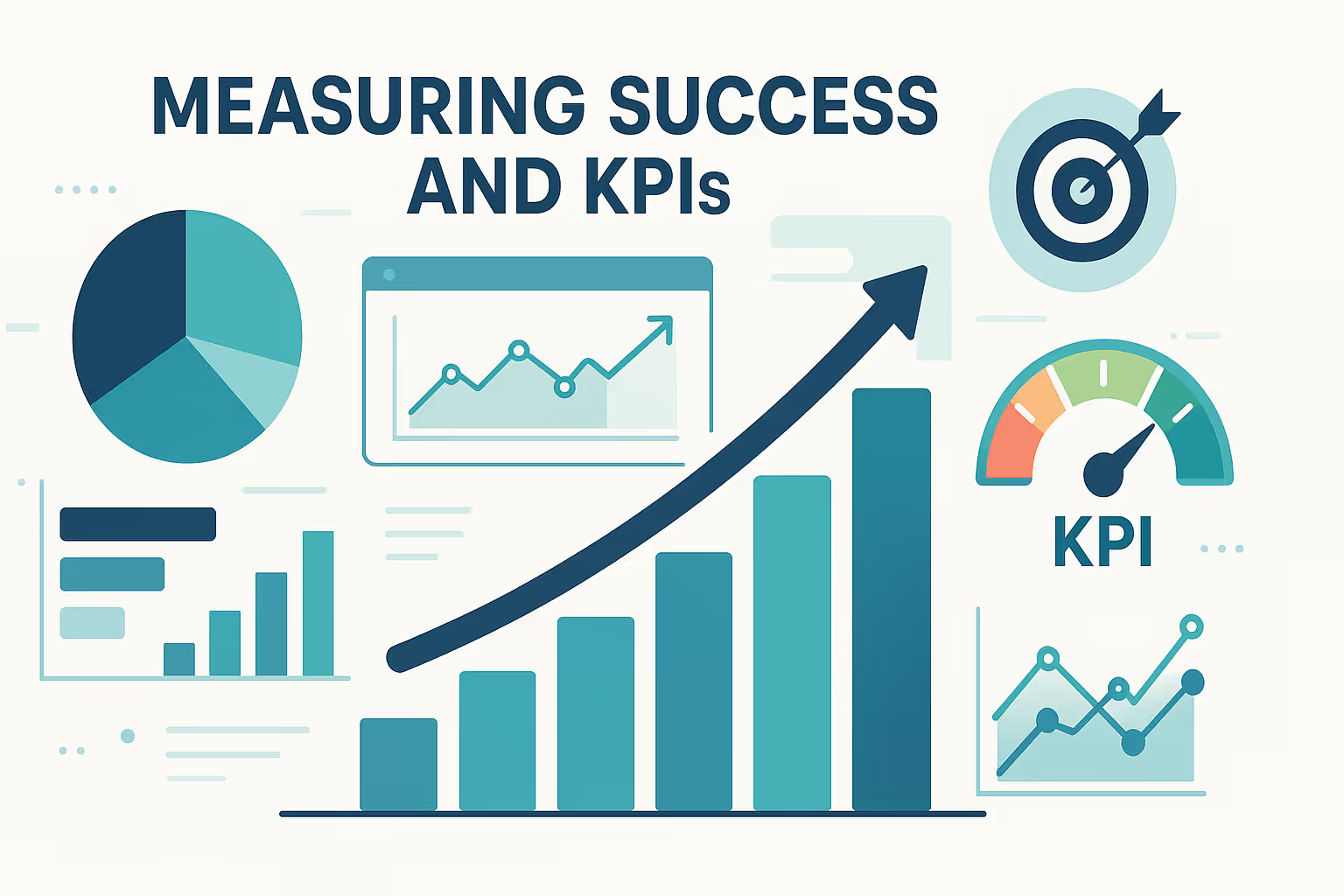
Essential Retention Metrics
Effective churn prevention requires all-round measurement across multiple dimensions:
Day 1, 7, 30 Retention Rates: Fundamental metrics tracking player return patterns. Industry benchmarks indicate good retention rates of 70-80% over 30 days, with monthly churn rates below 5%.
Player Lifetime Value (LTV): Total net profit expected from a player throughout their entire relationship. Advanced operators calculate predictive LTV using early behavioral signals rather than waiting for historical data.
Churn Rate Analysis: Percentage of players who stop engaging over defined time periods. Leading operators maintain churn rates below 5% monthly through proactive intervention strategies.
LTV Calculation and Optimization
Modern LTV calculation employs sophisticated modeling that goes beyond simple historical averages:
Basic Formula: LTV = ARPDAU × Lifetime, where ARPDAU represents Average Revenue Per Daily Active User and Lifetime reflects predicted engagement duration.
Advanced Predictive Models: Machine learning algorithms analyze early behavioral signals (D1/D3 retention, first purchase timing, tutorial completion) to forecast LTV within the first 24-72 hours.
Segmented Calculations: LTV varies significantly across player segments, requiring separate calculations for:
- Acquisition channels (organic vs. paid vs. affiliate)
- Geographic regions with different spending patterns
- Game preferences and platform usage patterns
- VIP status levels and engagement tiers
Advanced Analytics and Reporting
All-round retention measurement requires sophisticated analytics frameworks:
Real-Time Dashboards: Executive reporting that updates continuously with key retention metrics and early warning indicators
Cohort Analysis: Tracking specific player groups over time to identify long-term retention patterns and intervention effectiveness
Predictive Reporting: Forecasting models that project future churn risk and revenue impact of retention initiatives
A/B Testing Integration: Systematic testing of retention strategies with statistical significance tracking and automated winner identification
Continuous Improvement Frameworks
Successful retention programs employ iterative optimization methodologies:
- Weekly Review Cycles: Regular assessment of retention metrics with immediate tactical adjustments
- Monthly Strategic Reviews: Deeper analysis of program effectiveness with medium-term strategy modifications
- Quarterly Program Evaluation: Comprehensive assessment of technology, processes, and outcomes with major strategic decisions
- Feedback Loop Integration: Player survey data, support ticket analysis, and behavioral insights inform continuous program refinement.
Future Trends and Innovations
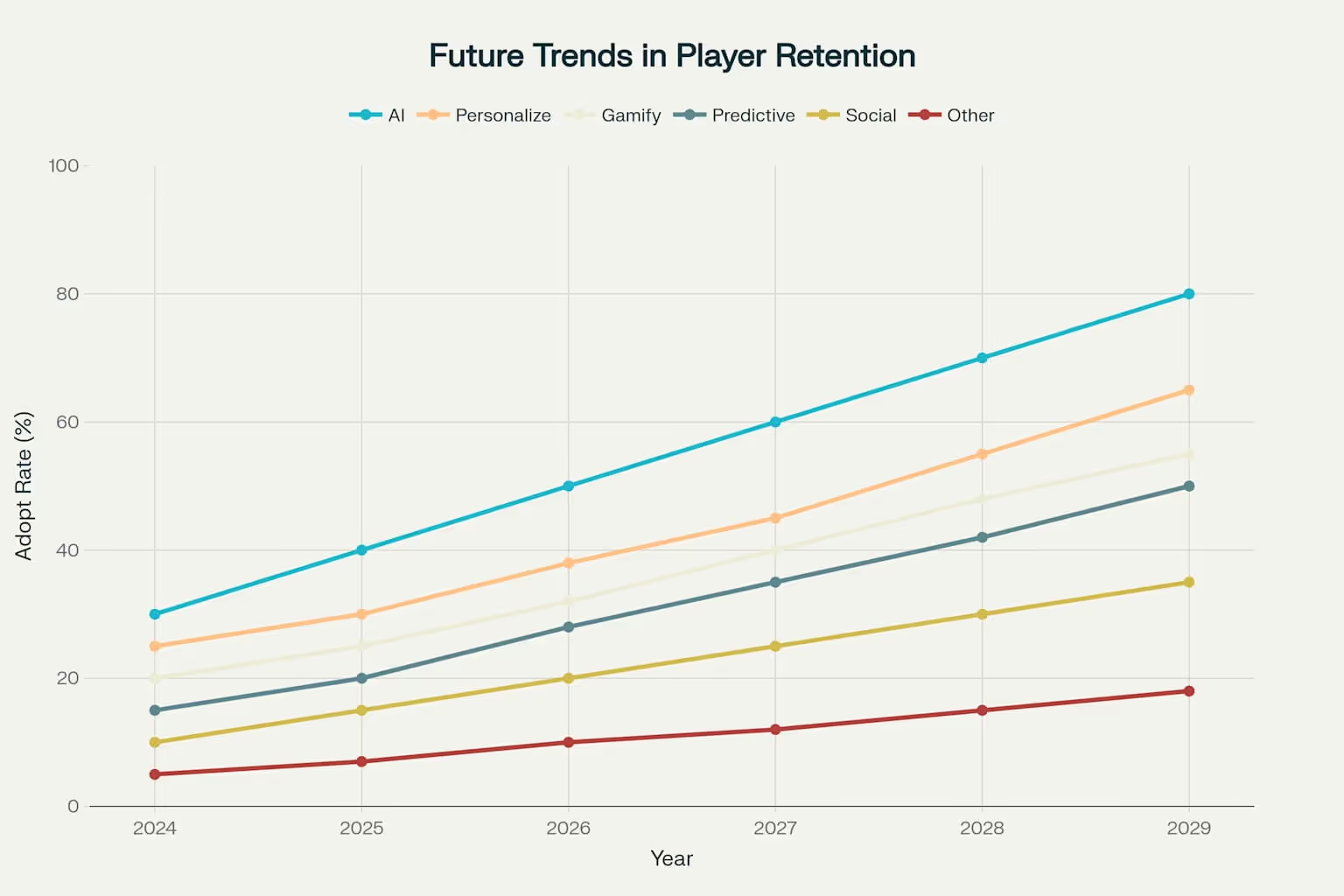
Emerging Technologies
The future of churn prevention will be shaped by several technological innovations:
- Virtual and Augmented Reality Integration: Immersive gaming experiences that create deeper emotional connections and higher engagement levels. VR casinos enable unprecedented personalization through environmental customization and social interaction.
- Blockchain and Cryptocurrency Integration: Transparent reward systems and instant transactions that reduce friction and enhance trust. Smart contracts can automate loyalty program benefits and create verifiable fairness in retention mechanics.
- Voice Interface Technology: AI-powered voice assistants that provide personalized recommendations and support, creating more natural player interactions.
Advanced AI Applications
Next-generation AI will enable even more sophisticated retention strategies:
- Neurogaming and Biometric Response Analysis: Real-time monitoring of player emotional states through biometric data to optimize engagement timing and intensity.
- Cross-Platform Behavioral Prediction: AI models that understand player behavior across multiple gaming platforms to create comprehensive engagement profiles.
- Predictive Personalization: Systems that anticipate player preferences before they're expressed, creating proactive rather than reactive retention strategies.
Regulatory Changes and Impact
Evolving regulations will reshape retention strategy implementation:
- Enhanced Privacy Requirements: Stricter data protection laws will require more sophisticated consent management and data minimization strategies.
- Responsible Gaming Integration: Mandatory player protection features will become integral to retention programs, requiring balance between engagement and harm prevention.
- Cross-Border Compliance: Harmonized international standards will enable more consistent retention strategies across multiple markets.
Industry Predictions for 2025-2030
Several trends will define the evolution of player retention:
- AI-First Architecture: Retention systems built around artificial intelligence rather than traditional rule-based approaches will become the industry standard.
- Real-Time Everything: Sub-second response times for all player interactions will become table stakes for competitive retention.
- Predictive Intervention: Prevention of churn before it occurs rather than reaction to churn signals will characterize leading operators.
- Holistic Player Experience: Integration of retention strategies across all touchpoints from gaming to customer service to payment processing.
Implementation Roadmap
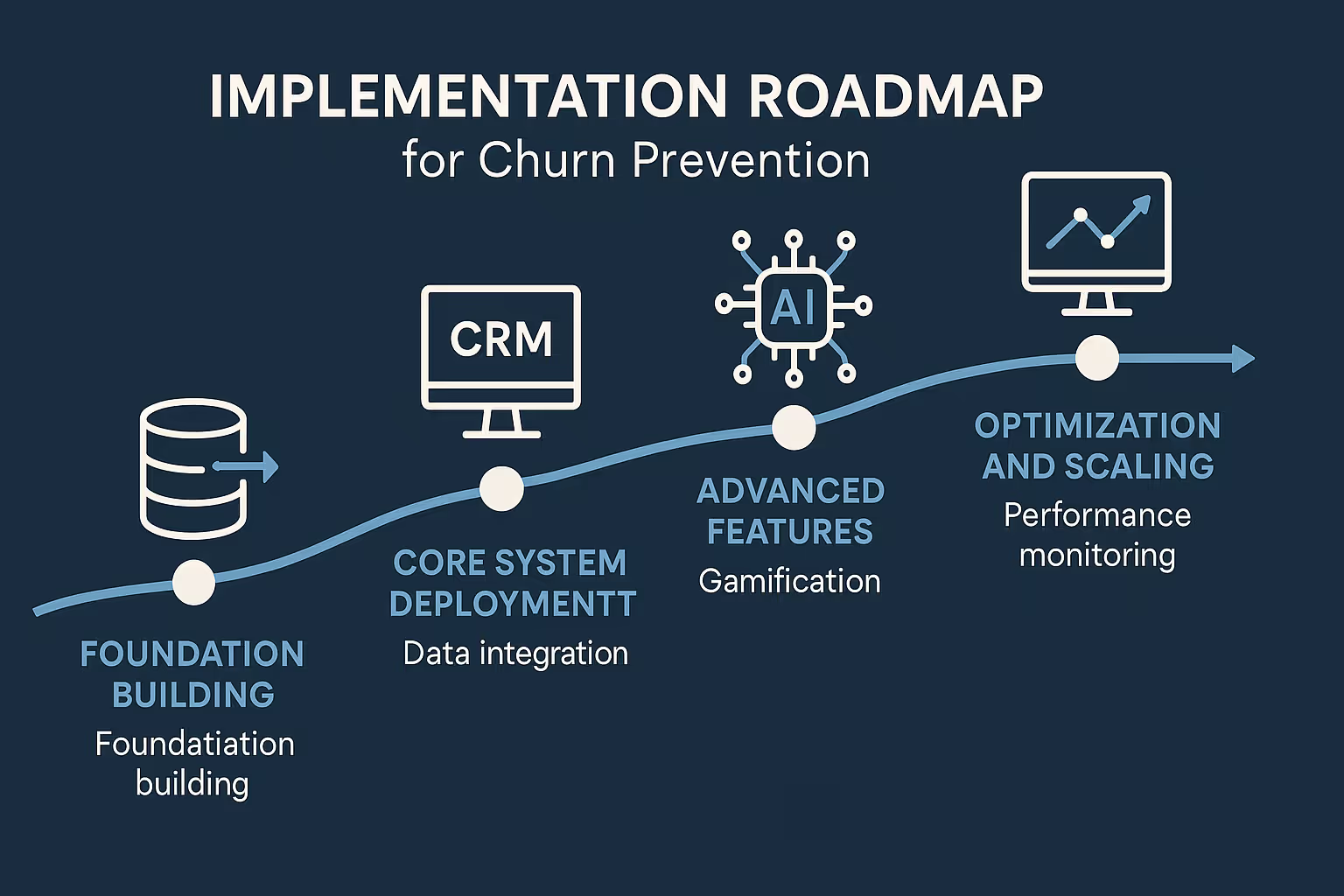
Step-by-Step Implementation Guide
Successful churn prevention implementation requires a structured approach:
Phase 1: Foundation Building (Weeks 1-4)
- Data integration and consolidation from all player touchpoints
- Baseline metric establishment for current retention performance
- Team training and process development for retention-focused operations
- Technology platform selection and initial configuration
Phase 2: Core System Deployment (Weeks 5-8)
- CRM and analytics platform implementation
- Basic segmentation model development using RFM analysis
- Automated communication workflow creation for standard retention campaigns
- Initial A/B testing framework establishment
Phase 3: Advanced Features (Weeks 9-12)
- AI-powered churn prediction model deployment
- Gamification system integration with personalization capabilities
- Real-time intervention capability activation
- Cross-channel campaign coordination implementation
Phase 4: Optimization and Scaling (Weeks 13-16)
- Performance monitoring and optimization based on initial results
- Advanced segmentation refinement using behavioral analytics
- Predictive model tuning for improved accuracy
- Full program launch with comprehensive measurement
Timeline Expectations and Milestones
Realistic implementation timelines vary based on organizational complexity and technology requirements:
Small to Medium Operators (Sub-1000 DAU):
- Basic retention program: 4-6 weeks
- Advanced AI integration: 8-12 weeks
- Full optimization: 16-20 weeks
Large Operators (1000+ DAU):
- Core system implementation: 8-12 weeks
- Advanced feature deployment: 16-24 weeks
- Enterprise optimization: 24-32 weeks
Critical Milestones:
- Week 4: Data integration complete with baseline metrics established
- Week 8: Automated retention campaigns operational
- Week 12: Predictive models deployed and tested
- Week 16: Full program operational with optimization cycles active
Resource Requirements and Team Structure
Effective retention programs require dedicated resources:
Core Team Composition:
- Retention Manager: Overall program strategy and execution
- Data Analyst: Metrics tracking and performance optimization
- CRM Specialist: Campaign development and automation management
- Technical Integration Lead: Platform implementation and maintenance
External Partner Requirements:
- Technology vendor support for platform implementation and training
- Consulting expertise for industry best practices and optimization
- Creative services for campaign asset development and testing
Common Pitfalls and Avoidance Strategies
Successful implementations avoid predictable failure modes:
Data Quality Issues: Ensure comprehensive data validation before building retention models. Poor data quality undermines all subsequent efforts.
Over-Personalization: Balance personalization with player privacy concerns. Excessive targeting can create discomfort and regulatory issues.
Technology Integration Challenges: Plan for complexity in system integration. Most implementations take 20-30% longer than initially estimated.
Measurement Paralysis: Focus on actionable metrics rather than comprehensive data collection. Start with essential KPIs and expand gradually.
Change Management Resistance: Invest in team training and process documentation. Retention programs require organizational commitment beyond technology deployment.
Smartico.ai Unified Platform Success
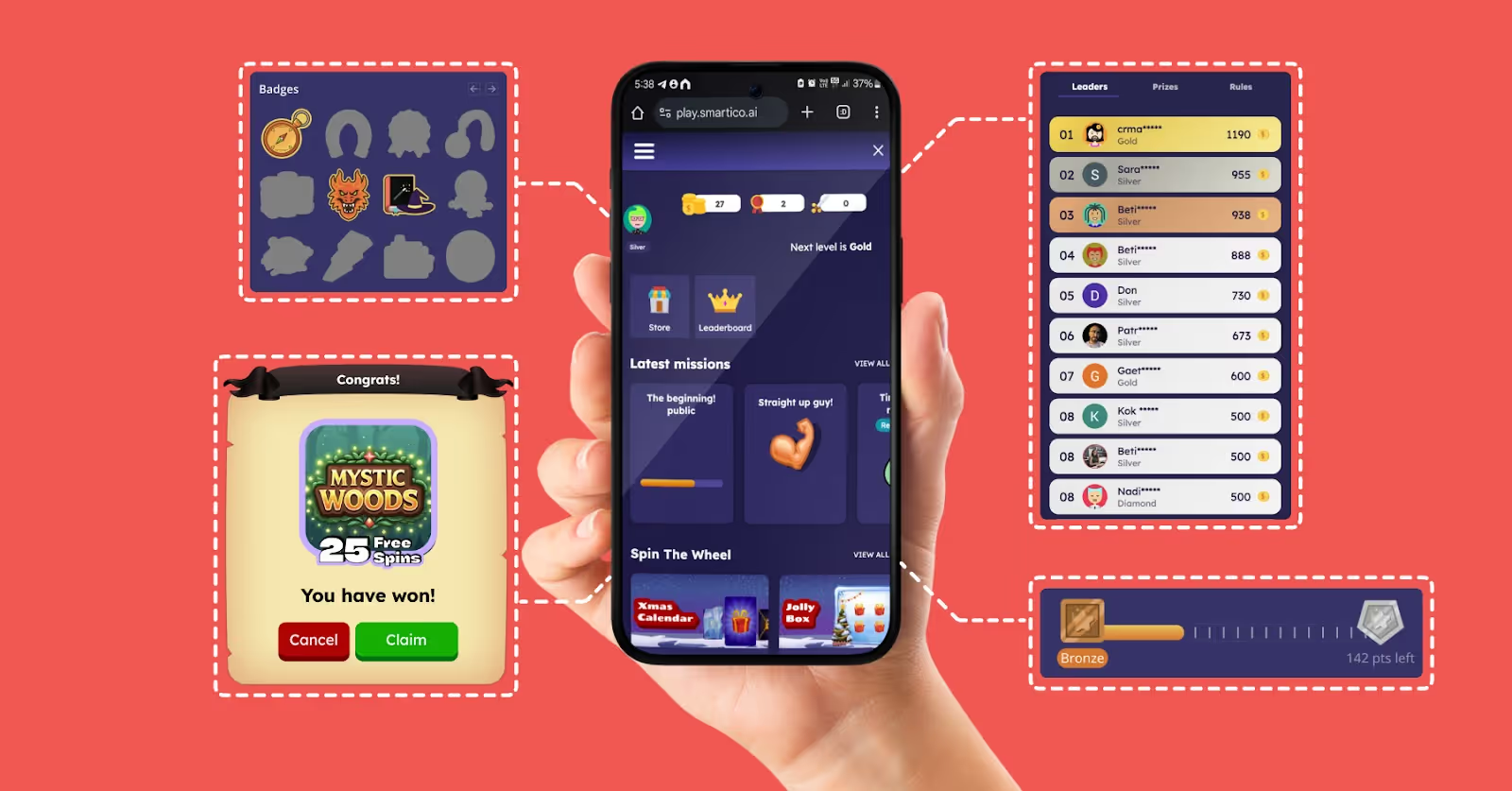
Smartico.ai established the industry standard as the first platform to unify iGaming CRM and Gamification in a single solution. While competitors have attempted to follow this approach, Smartico continues to set the benchmark for integrated retention technology.
It's unified architecture eliminates the complexity and integration challenges that plague operators using multiple point solutions. Instead of managing separate CRM, gamification, and analytics platforms, Smartico provides a single source of truth for all player data and engagement activities.
{{cta-banner}}
Feature Overview
Smartico's platform encompasses the full spectrum of retention technology requirements:
AI-Powered Churn Prediction and LTV Modeling: Machine learning models turn player data into actionable predictions, helping operators optimize engagement, prevent churn, and deliver rewards at the perfect moment.
Real-Time Gamification Tools: Customizable levels, points, tournaments, jackpots, spin-the-wheel, and mini-games integrate seamlessly within the CRM environment. Behavioral-based triggers automate responses to match player behavior.
Advanced Player Segmentation: RFM analysis and AI-driven micro-segmentation enable highly targeted campaigns that resonate with specific player groups.
Multi-Brand Management Capabilities: Operators can manage unlimited brands without extra costs, with brand-specific customization for unique campaigns, gamification settings, and bonuses.
Comprehensive Analytics and Reporting: Real-time dashboards and predictive analytics provide insights for continuous optimization and strategic decision-making.
Unique Differentiators
Smartico's competitive advantages extend beyond feature completeness:
Behavioral-Based Triggers and Automation: Optimal timing models reach players at the best moments to maximize engagement and conversion rates.
No Hidden Fees, All-Inclusive Pricing: Transparent pricing based on monthly active users includes both CRM automation and gamification capabilities without separate module fees.
Dedicated Success Managers: Expert-guided implementation and ongoing support ensures operators maximize platform value throughout the partnership.
Proven Results: Large LTV increases through gamification integration and measurable improvements in retention metrics across hundreds of client implementations.
Implementation and Support Excellence
Smartico's implementation methodology ensures rapid value realization:
Tailored Onboarding Process: Personalized setup from day one with deep training that empowers operator teams for long-term success.
Integration Expertise: Technical integration typically completed within 3 weeks with minimal effort required from operator technical teams.
Ongoing Partnership: Dedicated success managers provide continuous optimization guidance throughout the entire partnership duration.
Flexible Integration Options: Works with any platform and connects with any provider through flexible APIs and comprehensive system compatibility.
Conclusion: The Future of Player Retention
The online casino industry stands at a critical juncture where traditional acquisition-focused strategies are no longer sustainable. With retention rates declining and acquisition costs soaring, operators must embrace sophisticated churn prevention strategies to achieve long-term success.
The proven strategies outlined in this guide provide an all-round framework for transforming player retention through AI-powered analytics, gamification mechanics, and personalized engagement. Operators who implement these strategies systematically can expect strong improvements in retention rates and increases in lifetime value.
The economic imperative is clear: retaining existing players delivers 5-7 times better ROI than acquiring new ones. In an increasingly tough marketplace, churn prevention capabilities will determine which operators thrive and which struggle to survive.
Smartico.ai's unified CRM and gamification platform represents the evolution of retention technology, providing operators with the tools, expertise, and support necessary to implement world-class churn prevention strategies. The combination of advanced AI capabilities, proven gamification mechanics, and dedicated partnership support creates an unmatched foundation for retention success.
The time for action is now. Operators who delay implementing comprehensive churn prevention strategies risk falling behind competitors who recognize retention as the key to sustainable profitability. The tools, knowledge, and expertise exist today to transform player retention - the question is which operators will seize this competitive advantage.
Ready to transform your player retention strategy? Book your free, in-depth demo of Smartico.ai below and find out how the industry's leading unified CRM and gamification platform can revolutionize your approach to churn prevention.
{{cta-banner}}
Did you find this article helpful? If so, consider sharing it with other industry professionals such as yourself.
Ready to use Smartico?
Join hundreds of businesses worldwide engaging players with Smartico.










